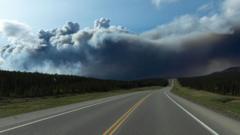The International Space Station (ISS) has recently provided a spectacular view of the aurora borealis, showcasing vibrant greens and reds illuminating the night sky over Canada. This phenomenon, commonly known as the Northern Lights, is generally witnessed from the ground, particularly in regions near the Arctic Circle. However, the vantage point from space offers a unique perspective.
Astronaut Captures Stunning Northern Lights from Space Station

Astronaut Captures Stunning Northern Lights from Space Station
A mesmerizing display of the aurora borealis has been filmed from the International Space Station. This breathtaking view highlights the natural beauty of the Northern Lights, particularly over Canada.
The breathtaking display occurs when the solar wind—a stream of charged particles emitted by the sun—collides with Earth’s magnetic field. This interaction generates stunning light displays as charged particles enter the atmosphere. The footage captured in January 2025 also reveals the shimmering city lights below, as the ISS orbits approximately 259 miles (417 km) above the Atlantic Ocean and then ascends into the dawn.
This extraordinary observation not only delights the viewers but also enriches our understanding of auroras and their relationship with solar activity. As scientific interest continues to grow, insights from these discoveries could enhance our comprehension of the Earth’s magnetic field and its interactions with solar phenomena. The stunning imagery serves as a reminder of the beauty that surrounds our planet and its dynamic systems.
This extraordinary observation not only delights the viewers but also enriches our understanding of auroras and their relationship with solar activity. As scientific interest continues to grow, insights from these discoveries could enhance our comprehension of the Earth’s magnetic field and its interactions with solar phenomena. The stunning imagery serves as a reminder of the beauty that surrounds our planet and its dynamic systems.





















